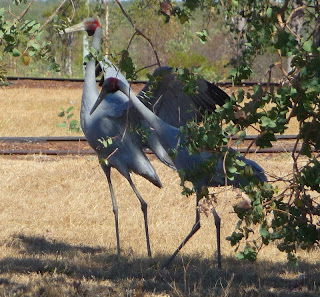First thing this morning we continued our tour of Normanton. Just at the end of our street there is a good view of the wetlands area in which the magpie geese, brolgas and jabirus congregate. We spent a few minutes looking at these birds before driving out to the Railway Station where the Gulflander train is kept. This old train started its route in 1891 to bring gold from Croydon to Normanton for shipping south. These days it only runs on a Wednesday down to Croydon and returns on a Thursday, and, much to Garry's disappointment, those times were not suitable for us. He went off to investigate the station more fully while I phoned Mum.
 |
| The Normanton Railway station |
We had only been chatting for a few minutes when I had to put Mum on hold as two huge brolgas glided down and landed in front of the car. For me these birds, together with the jabiru, epitomize the tropical north. I think they are really beautiful and I always get a thrill when I see them. They are so big and stately and it is unusual, at least on this trip, for us to see them up close.
After some time just watching the antics of these two who were prancing and flapping, obviously one trying to impress the other, and about 100 photos, we went back to the bakery where we bought just-made fresh cream buns and then drove on to the old wharf area and bridge across the Norman River. This river is full of crocs and it is wide and fast flowing. Most people come to this area for the fishing but it is visually lovely as well. We had our morning coffee on the old bridge then set off for Karumba, a further 70kms away on the Gulf.
 |
| The Norman River |
There were lots of other birds as well. A massive flock of white corellas had colonized a tree and they were literally perched on every available twig. Every once in a while something would alarm them and there would be a cloud of white before they settled down again.
In the water and circling overhead were also large numbers of pelicans; and in the waterhole was a couple of jabiru, which now must be called black-necked storks. Apparently some other country has a jabiru also and it took Australia to court and won the right to the name, so we had to change ours.
 |
| Pelicans ... |
Then, just outside of Karumba we saw some more ponds and these had kangaroos as well as birds happily feeding around them. I am assuming that in the wet the habitat of these birds is much more free-ranging, but in the dry they are forced to congregate around the more "suitable" waterholes. It certainly is a spectacle that has worked in my favour.
 |
| Note the beautiful Kingfishers |
Even though there may seem to be a lot of photos here, I have done really well given the number I had to choose from ... and then we got to Karumba !!!
This small town has two parts and we firstly went to the township. Here were the usual shops and we stopped at "Raptis", the Prawn Works, to buy some fresh prawns @ $15 / kilo. Garry also priced the oysters for future enjoyment. Then we drove out to the Point which is another small settlement, still Karumba though, and where we had booked a site.
We got a brilliant spot at the park, in full shade all day with a breeze off the water and across the road from the beach. The park is very tropical with lots of palm trees and we initially booked in for 2 days. Over coffee we decided to extend that to 5 days; then over dinner we decided on 7 days ! But we are leaving our options open. We may even stay longer!!
We waited until late in the afternoon to explore and firstly we went over to the beach. Karumba only has the one tide each day and it was high when we arrived but by 6pm, much of the mud flats had been exposed. While the actual beach is safe, we will not be going for a stroll anywhere near these mud flats as this is serious crocodile country. At the Point there are a number of interesting little shops that sell absolutely EVERYTHING and also a hotel. It has a huge beer garden opening on to the water and the sun sets directly in front. We are actually facing west here and looking across the Gulf towards Arnhem land. I am sure that we will be enjoying views similar to these every night we are here.
 |
| Linda at the Gulf |
As it started to darken around 7pm we decided to try the "world famous" fish and chip shop, Ash's, and it fully lived up to its reputation. The barra was melt in your mouth and we will be eating a lot more of that while we are here.
This place is just beautiful, and really perfect for a bit of a rest from being on the move most days. I intend to complete a lot of French and Garry assures me he will not be bored. He has been given the job of planning each day so that will keep him busy.
This park is across the road from us and we will be spending quite a bit of time there in the next week I think.






















































